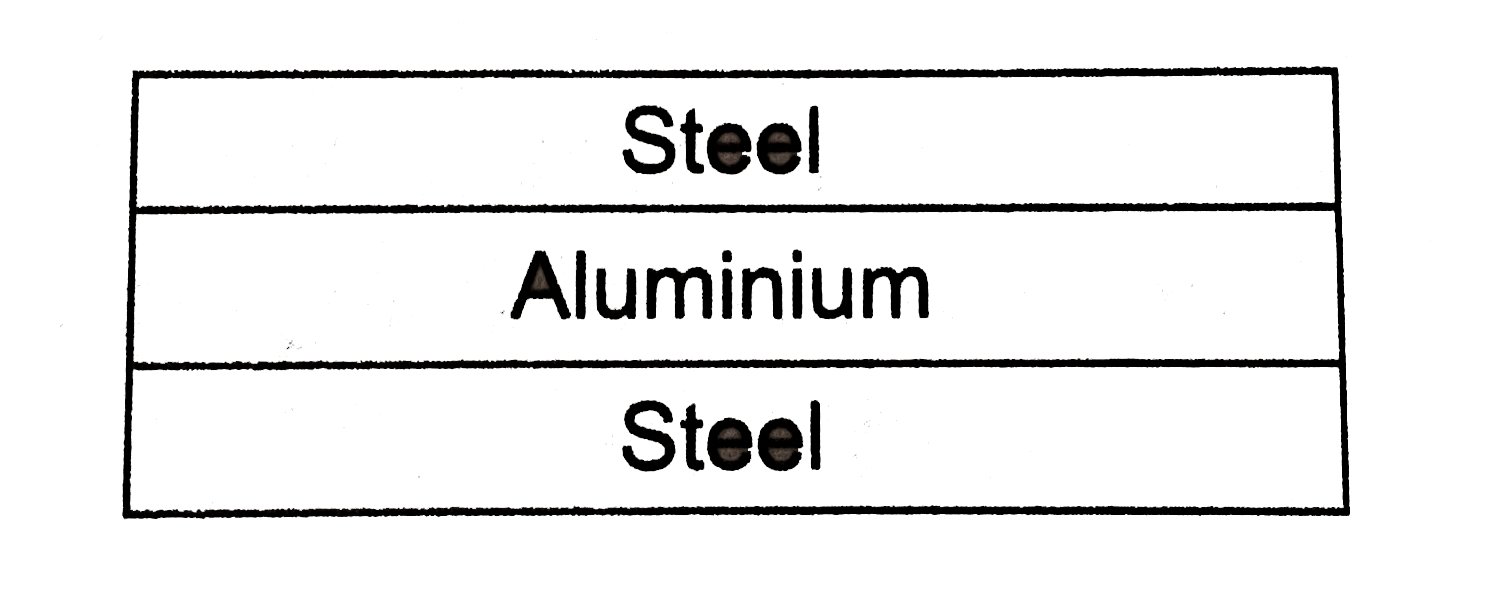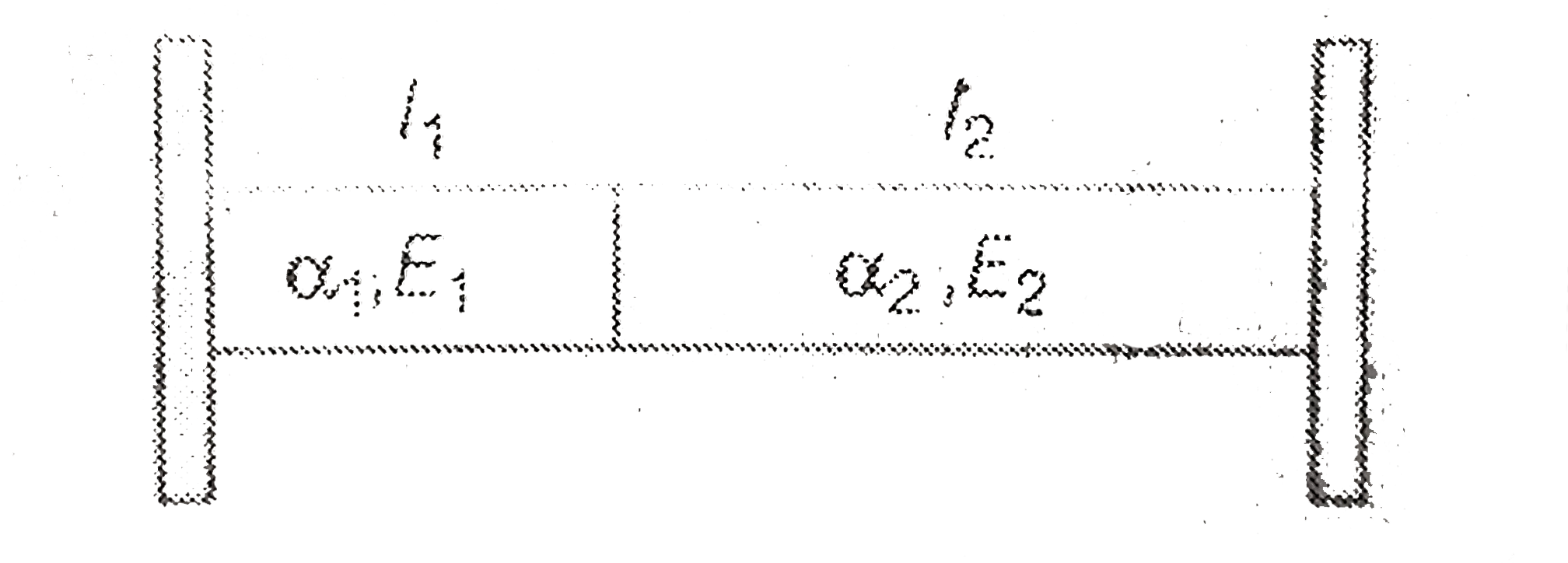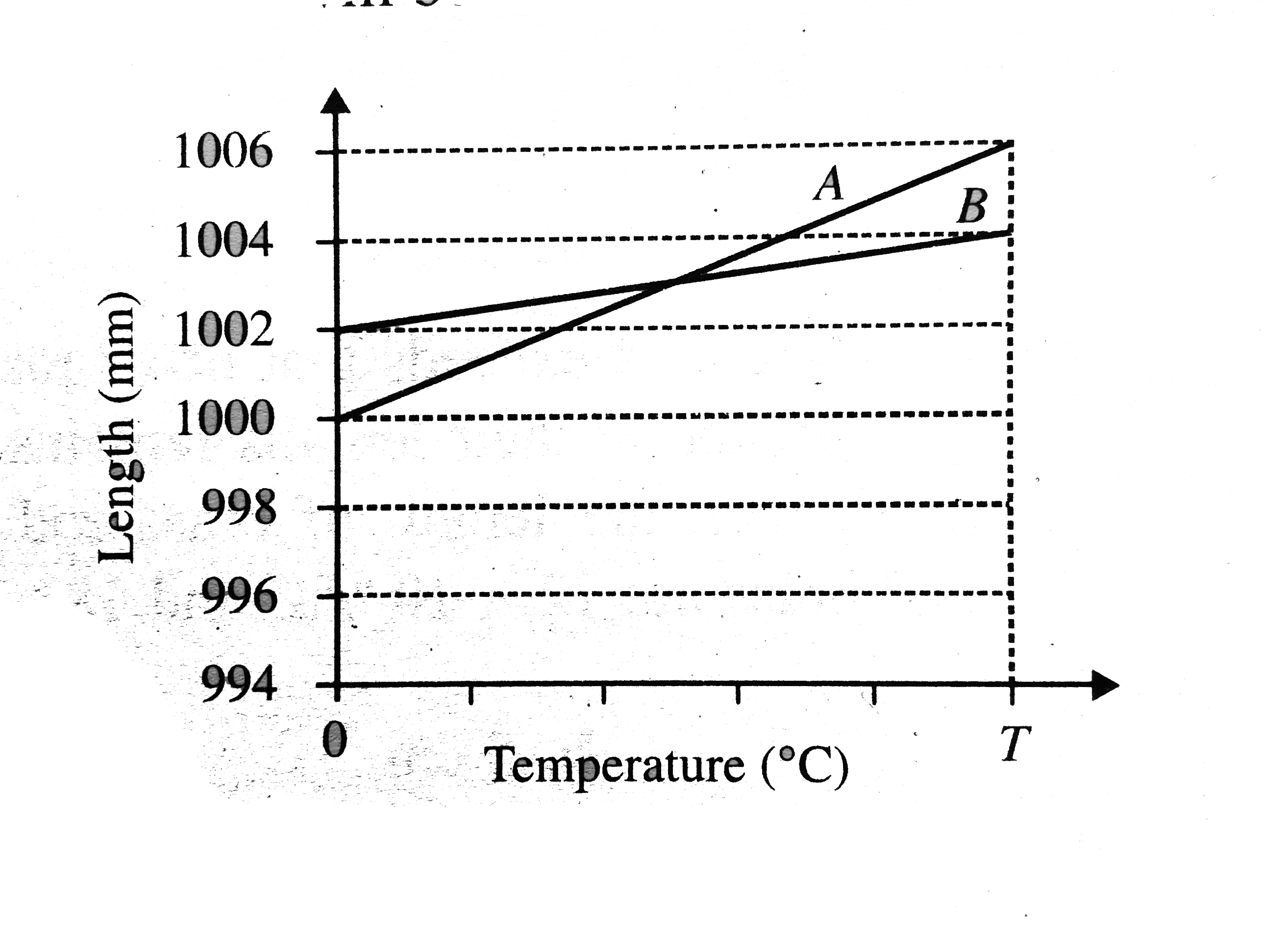Two steel rods and an aluminium rod of equal length l0 and equal cross- section are joined rigidly at their ends as shown in the figure below. All the rods are in a state of zero tension at 0∘C. Find the length of the system when the temperature is raised to θ. Coefficient of linear expansion of aluminium and steel are αa and αs respectively. Young's modulus of aluminium is Ya and of steel is Ys.
The correct Answer is:A, B
To find the length of the system when the temperature is raised to θ, we will follow these steps:
Step 1: Understand the Initial Conditions
At 0°C, the initial length of each rod is L0, and they are in a state of zero tension. This means that the rods are not experiencing any stress at this temperature.
Step 2: Define the Change in Length
When the temperature is raised to θ, the change in length for each rod can be expressed using the formula for linear expansion:
ΔL=L0⋅α⋅ΔT
where ΔT=θ−0=θ.
Step 3: Calculate the Change in Length for Each Rod
- For the two steel rods, the change in length will be:
ΔLs=L0⋅αs⋅θ
Thus, for two steel rods, the total change in length is:
ΔLtotal,s=2⋅ΔLs=2⋅L0⋅αs⋅θ
- For the aluminum rod, the change in length will be:
ΔLa=L0⋅αa⋅θ
Step 4: Total Change in Length
The total change in length of the system when the temperature is raised to θ is the sum of the changes in length of all three rods:
ΔLtotal=ΔLtotal,s+ΔLa=2⋅L0⋅αs⋅θ+L0⋅αa⋅θ
Step 5: Express the Final Length
The final length L of the system at temperature θ can be expressed as:
L=L0+ΔLtotal
Substituting the expression for ΔLtotal:
L=L0+(2⋅L0⋅αs⋅θ+L0⋅αa⋅θ)
Factoring out L0:
L=L0(1+2αsθ+αaθ)
Step 6: Simplify the Expression
This can be further simplified to:
L=L0(1+θ(2αs+αa))
Final Expression
Thus, the final length of the system when the temperature is raised to θ is:
L=L0(1+θ(2αs+αa))
At 0°C, the initial length of each rod is L0, and they are in a state of zero tension. This means that the rods are not experiencing any stress at this temperature.
When the temperature is raised to θ, the change in length for each rod can be expressed using the formula for linear expansion:
ΔL=L0⋅α⋅ΔT
where ΔT=θ−0=θ.
- For the two steel rods, the change in length will be:
ΔLs=L0⋅αs⋅θ
Thus, for two steel rods, the total change in length is:
ΔLtotal,s=2⋅ΔLs=2⋅L0⋅αs⋅θ
ΔLa=L0⋅αa⋅θ
The total change in length of the system when the temperature is raised to θ is the sum of the changes in length of all three rods:
ΔLtotal=ΔLtotal,s+ΔLa=2⋅L0⋅αs⋅θ+L0⋅αa⋅θ
The final length L of the system at temperature θ can be expressed as:
L=L0+ΔLtotal
Substituting the expression for ΔLtotal:
L=L0+(2⋅L0⋅αs⋅θ+L0⋅αa⋅θ)
Factoring out L0:
L=L0(1+2αsθ+αaθ)
This can be further simplified to:
L=L0(1+θ(2αs+αa))
Thus, the final length of the system when the temperature is raised to θ is:
L=L0(1+θ(2αs+αa))
Topper's Solved these Questions
- BOOK - DC PANDEY ENGLISHCHAPTER - THERMOMETRY,THERMAL EXPANSION & KINETIC THEORY OF GASESEXERCISE - Level 2 More Than One Correct7videos
THERMOMETRY,THERMAL EXPANSION & KINETIC THEORY OF GASES
- BOOK - DC PANDEY ENGLISHCHAPTER - THERMOMETRY THERMAL EXPANSION AND KINETIC THEORY OF GASESEXERCISE - Medical entrance gallary30videos
THERMOMETRY THERMAL EXPANSION AND KINETIC THEORY OF GASES
- BOOK - DC PANDEY ENGLISHCHAPTER - UNIT AND DIMENSIONSEXERCISE - Assertion And Reason2videos
UNIT AND DIMENSIONS
Similar Questions
Two steel rods and an aluminum rod of equal length l0 and equal cross section are joined rigidly at their ends as shown in the figure below. All the rods are in a state of zero tension at 0∘C. Find the length of the system when the temperature is raised to θ. Coefficient of linear expansion of aluminum and steel are αaandαs respectively. Young's modulus of aluminum is Ya and of steel is Ys.
 View Solution
View SolutionA steel rod is clamped at its two ends and rests on a fixed horizontal base. The rod is unstrained at 20∘C. Find the longitudinal strain developed in the rod if the temperature rises to 50∘C. Coefficient of linear expansion of steel =1.2×10−5C−1.
View SolutionA steel rod is clamped at its two ends and rests on a fixes horizontal base. The rod is unstrained at 20∘C. Find the longitudinal strain developed in the rod if the temperature rises to 50∘C. Coefficient of linear expansion of steel =1.2×10−5∘C−1.
View SolutionA steel rod is clamped at its two ends and rests on a fixes horizontal base. The rod is unstrained at 20∘C. Find the longitudinal strain developed in the rod if the temperature rises to 50∘C. Coefficient of linear expansion of steel =1.2×10−5∘C−1.
View SolutionWhat should be the sum of lengths of an aluminium and steel rod at 0∘C is, so that all the temperature their difference in length is 0.25m. (Take coefficient of linear expansion for aluminium and steel at 0∘C as 22×10−6/.∘C and 11×10−5/.∘C respectively.)
View SolutionA thin rod, length L0 at 0∘C and coefficient of linear expansion α has its two ends mintained at temperatures θ1 and θ2 respectively Find its new length .
View SolutionTwo rods of different materials are placed between massive walls as shown in figure. The cross section of the rods is A, their moduil of elastricity are E1 and E2 respectively. If rods are heated by t degrees, then (coefficients of liner expansion of material of rods are α1 and α2 respectively)
 View Solution
View SolutionTwo rods of equal cross sections area are joined end the end as shown in figure. These are supported between two rigid vertical walls. Initially the rods are unstrained .
_E01_227_Q01.png)
If temperature of system is increased by ΔT then junction will not shift if -View Solution
The variation of length of two metal rods A and B with change in temperature is shown in Fig. the coefficient of linear expansion αA for the metal A and the temperature T will beView SolutionThe length of two metallic rods at temperatures θ are LA and LB and their linear coefficient of expansion are αA and αB respectively. If the difference in their lengths is to remian constant at any temperature then
View Solution

